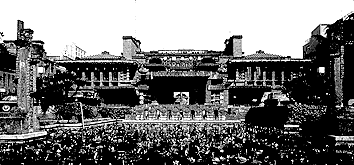 Video of the Ken Burns PBS Frank Lloyd Wright miniseries now
available. Click here (or click on the picture of the video) to order
Video of the Ken Burns PBS Frank Lloyd Wright miniseries now
available. Click here (or click on the picture of the video) to order
 Video of the Ken Burns PBS Frank Lloyd Wright miniseries now
available. Click here (or click on the picture of the video) to order
Video of the Ken Burns PBS Frank Lloyd Wright miniseries now
available. Click here (or click on the picture of the video) to order
Summary: Listings and information about Frank Lloyd Wright's
buildings in Japan.
All-Wright Site Links: [Building
Guide - top of page] [Building Guide -
Map] [All-Wright Site Main Page]
[E-mail] [Books]
The links on this page were all
last updated and verified November 10, 1998.
Please
let me know if you encounter any bad links, or have new ones to
suggest
 Frank
Lloyd Wright designed 12 buildings for Japan.
Of these, 6 were built, and of these 2 remain whole
and 1 is found in parts. (the Aisaku Hayashi house was
demolished just a few years ago). These
three existing buildings are listed with Web resources.
Frank
Lloyd Wright designed 12 buildings for Japan.
Of these, 6 were built, and of these 2 remain whole
and 1 is found in parts. (the Aisaku Hayashi house was
demolished just a few years ago). These
three existing buildings are listed with Web resources.
From the time of the Columbian Exposition in Chicago in 1893 with the Japanese "Ho-o-Den" display, the famous American architect Frank Lloyd Wright was influenced in some ways by Japanese art. Wright reported that he found Japanese art "nearer to the earth . . . than any European civilization alive or dead." He was an astute and avid collector of Japanese art prints as well. A preliminary sketch of one house design, the Thomas Hardy House in Wisconsin, was done in a Japanese style. Mr. Wright's work has had some influence in Japan, as well: the building known as the Japanese "White House" is inspired by his design.
General interest sites pertaining to Frank Lloyd Wright's work in Japan:
Individual building listings:
Imperial Hotel (S.194, S.195), Tokyo, Japan,
1915.
One of Mr. Wright's grandest, largest, and most detailed designs,
this one was demolished in 1968, but the entrance lobby survives
at the Meiji Village. Mr. Wright spent much time in Japan overseeing
its construction. The hotel was built on a special floating foundation,
and as a result, rode out the Kanto earthquake of 1923 with little
damage. The building was used by the American army during the
occupation following World War II.
This project is one of several large and significant non-residential Wright projects (along with the Larkin Building and Midway Gardens) built in the first "golden age" of his career which have long since been demolished.

American Embassy in Japan, 1914, unbuilt.
Odawara Hotel, 1917, unbuilt.
Aisaku Hayashi House (S.206), Tokyo, Japan, 1917.
Arinobo Fukuhara House (S.207), Hakone, Japan, 1918.
Mihara Housel, 1918, unbuilt.
Eiga Motion Picture Theatre, 1918, unbuilt.
Tazaemon Yamamura House (S.212),
Ashiya, Japan, 1918
Baron Shinpei Goto House, 1921, unbuilt.
Jiyu-Gakuen Girls' School (S.213) , Toyko, Japan, 1921.
Other
No other buildings or pages of interest at this time. Please
send e-mail if you have any to suggest.
This one-story house had a pond in the yard. The client was the
manager of the Imperial Hotel. It was demolished recently.
This home was destroyed by earthquake in 1923.
This, the only surviving Wright residence in Japan, is located on
a hillside which faces south to Osaka Bay. It is constructed of a soft
lava called "Oya stone" and of mahogany. In order of construction of
Wright buildings, it was built between two significant California
designs: the Hollyhock House and
the first of the concrete block houses

 Books
Books
 The All-Wright Site - Frank Lloyd Wright
Building Guide (including
this page) has been accessed
The All-Wright Site - Frank Lloyd Wright
Building Guide (including
this page) has been accessed
times since (and including) 03/01/96, according to the digits.com web
counter. This Japan page has been accessed
times since June 20, 1998 according
to the Geocities web counting system.
Click here to return to the Frank Lloyd
Wright Building Guide main
page, or click here to return to the
All-Wright Site main page.
![]() Get your own Free Home Page
Get your own Free Home Page